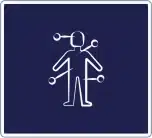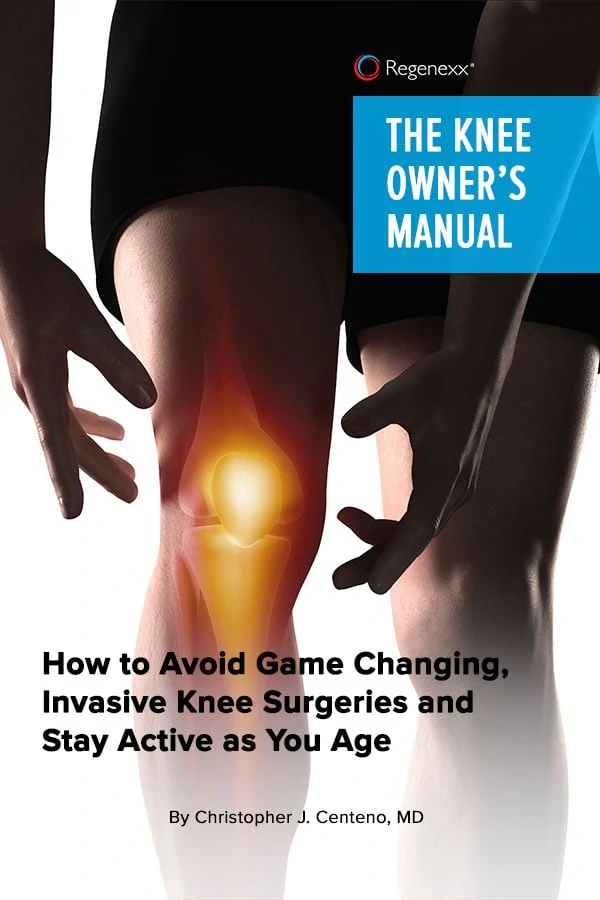What Are Regenexx Procedures for Knees?
Regenexx® procedures use sophisticated image-guided injections to place high-dose platelet-rich plasma (PRP) or bone marrow concentrate containing stem cells in critical areas to help the body heal itself. As the headquarters of Regenexx, Centeno-Schultz is where all of these procedures used by our national network began and were invented. These are breakthrough, non-surgical treatments for people suffering from knee pain due to common injuries to the knee meniscus, ACL or MCL, cartilage, or who are experiencing degenerative conditions, such as osteoarthritis. So, if you’re looking for an alternative to surgery for knees in Denver or Boulder, Colorado, then look no further than the Centeno-Schultz Clinic.
Traditional options for patients suffering from these conditions include arthroscopic knee surgery to repair ligament tears, or total knee joint replacement. With both surgeries, months of rehab are required, and the patient must be aware of and prepared to take on the risks. As an alternative, the Regenexx Same-Day procedure may help alleviate knee pain and the conditions that cause it with a sophisticated office injection procedure.
Looking for alternative to knee surgery?
What you really need are highly precise procedures that place the right cells in all the critical locations they’re needed.
Quick Links
Meniscus Tears
Meniscus tears are one of the most common injuries we treat. The last option anyone should consider for treating a meniscus injury is the surgical removal of all or some of this important structure. Click below to learn why Regenexx is likely a better choice than meniscus surgery.
ACL Tears
Knee ACL tears are a very common injury. The rush to surgery has long been due to the traditional thinking that an ACL will not heal, which is why we offer our ACL surgery alternative. Our experience treating ACL tears with precise image-guided injections into the ACL has shown that it may be a better option for those who have experienced a partial or complete non-retracted ACL tear.
Knee Arthritis
Knee replacement surgery comes with many serious risks and complications but is often considered to be a straightforward and accepted approach to treatment for those suffering from significant arthritis or injury in this joint. Before you consider knee replacement, learn what our sophisticated image-guided procedures can do for you.
Commonly Treated Knee Conditions
Regenexx’s non-surgical knee treatment can treat many knee conditions. Those include, but are not limited to, the following:
ACL Tears
The Anterior Cruciate Ligament (ACL) is one of four major ligaments in the knee. It is an important stabilizer of the knee and prevents the shin bone (tibia) from sliding in front of the thigh bone (femur). The ACL is susceptible to injury. It is most likely to be injured during activity or by impact. A torn ACL is a common injury for athletes at all levels, but it is most common for people who are active or who experience impact injuries to the knee. ACL injuries can happen to anyone of any age, condition, or ability, and it can be injured in many ways. Examples include abruptly changing direction, slowing down while running, landing incorrectly, or getting struck by someone or some object.
Read More About ACL TearsBaker’s Cyst
A Baker’s cyst can cause knee pain. A Baker cyst is swelling caused by fluid from the knee joint protruding to the back of the knee. They are NOT a true cyst since it has communication with the synovial sac. They typically arise from degenerative changes or injury to the articular cartilage (arthritis) or meniscus. At the Centeno-Schultz Clinic, we believe that baker’s Cysts are simply a barometer of the health of the knee joint. In a healthy knee, there are absent whereas with injury and degenerative changes they are common. They arise between the tendons of the medial head…
Read More About Baker’s CystBone Spurs In The Knee
Bone spurs, also known as osteophytes, are abnormal growths that can form along any bony surface in the body. They most frequently occur where tendons and ligaments attach to the bone. As a result, they are more commonly seen in large mobile joints that support weight, such as the hips, spine, ankles, or knees. Surprisingly, most bone spurs are relatively benign but are a clinical sign of instability in the area. Research demonstrates that if a ligament has laxity, the constant strain at the insertion into the bone will elevate the surface of the bone, creating additional bone formation – this is known as a traction osteophyte.
Read More About Bone Spurs In The KneeChondromalacia
Chondromalacia is the knee usually causes pain, typically around the kneecap or deep in the kneecap. You can also have some grinding sensations or crepitus which are sounds and noises coming from around the knee with certain motions. Typically, pain and grinding sensations are worse with bending the knee, especially for prolonged periods of time, kneeling on the knee, walking downstairs, or running downhill. Standing after prolonged sitting or an immobility period where the knee is bent can cause some discomfort as well. Some people may experience swelling, others may experience locking or catching in the knee, feeling the knee wants to give out, or a feeling of weakness….
Read More About ChondromalaciaEhlers-Danlos Syndrome (EDS)
Disorders that affect and weaken the connective tissues such as tendons and ligaments. It is a hereditary disorder which means you are born with it. EDS has many different signs and symptoms which can vary significantly depending upon the type of EDS and its severity. It most commonly affects the skin, joints, and blood vessels. Joints are typically hypermobile with excessive joint range of motion because of a defect in collagen formation. In most cases Ehlers-Danlos syndrome is inherited. That is to say that you are born with it. The two main ways EDS is inherited are: autosomal dominant inheritance and autosomal recessive inheritance…
Read More About Ehlers-Danlos Syndrome (EDS)Hamstrings Tendinopathy
Hamstring tendinopathy, a condition that causes pain and tenderness in the hamstring tendons, represents a common but often misunderstood musculoskeletal issue. It typically occurs in athletes and individuals engaged in high-intensity activities but isn’t limited to them. This condition, including its more specific form, high hamstring tendinopathy, can significantly impact daily and athletic performance, making understanding its nuances critical.
Read More About Hamstrings TendinopathyIliotibial Band Syndrome (ITBS)
Also known as “IT Band Syndrome” also known as “ITB Syndrome,” iliotibial band syndrome is a painful medical condition that affects the lateral hip, leg, and knee. It can affect individuals of all ages and most often is caused by repetitive activities like running, cycling, hiking, and walking. Your iliotibial band is a thick band of connective tissue that runs from the outside of your hip down to the outside aspect of your knee. Its principal function is to stabilize the hip and knee. If it becomes tight and dysfunctional, you may experience pain along with this band of tissue due to strain or inflammation. You may also experience pain, limited range of motion in…
Read More About Iliotibial Band Syndrome (ITBS)Knee Arthritis
In the human body, a joint is simply where 2 ends of bone come together. At the ends of these bones, there is a thick substance called “Hyaline Cartilage” that lines the ends. Hyaline cartilage is extremely slippery which allows the two ends of the bone to slide on top of each other. Then there is a capsule that connects the two ends filled with “synovial fluid” that acts as a further lubricant to make it more slippery! Arthritis in the knee is defined by loss of the hyaline cartilage plus other changes that happen to the bone such as additional bone being laid down (bone spurs/osteophytes). The cartilage layer is worn down to the point of exposing the underlying bone they cover…
Read More About Knee ArthritisKnee Instability
Knee instability is a condition that results when the knee joint is unstable and does not move or function normally. This can cause the knee to feel like it is going to give out or buckle. Knee instability can be caused by a variety of factors, including trauma or injury to the knee, ligament injury, arthritis or other degenerative diseases of the knee, weakness or instability of the muscles around the knee, muscle atrophy, injury to another joint in the body creates an imbalance. Knee stability, and stability in general, is very important. Lack of knee stability can lead to more problems over time, such as pain and arthritis…
Read More About Knee InstabilityMCL tear
The medial collateral ligament AKA MCL is a thick, strong band of connective tissue on the inside portion of your knee. It connects the top part of the tibia (shin) to the bottom part of the femur (thigh). This is a vital ligament that works along the lateral collateral ligament (LCL), anterior cruciate ligament (ACL), and posterior cruciate ligament (PCL) to bring stability, structure, and movement to the knee. The MCL provides support and stability for the inside (medial) aspect of the knee. MCL tears are a common injury in sports such as football, hockey, and skiing. The ligament can…
Read More About MCL tearMeniscus Tears
The meniscus is a c-shaped piece of cartilage in the knee that functions as an important shock absorber. It is sandwiched between the thigh and shin bone. There are two menisci per knee. One on the inside portion of the knee (medial) one on the outside aspect (lateral). The knee meniscus is susceptible to injury. The most common injury is a tear in the meniscus. Not all meniscus tears however cause pain. When symptomatic a meniscus tear can cause pain, swelling, and restriction in range of motion. Tears in the knee meniscus can arise from trauma or degeneration. There are many different types of meniscus tears based upon locations….
Read More About Meniscus TearsOsteoarthritis (OA)
The labrum is a cartilaginous cup that circles the shallow shoulder socket (the glenoid) to make the socket deeper. The labrum supports and stabilizes the shoulder joint. Causes of Shoulder Labral Tears Injury to the labrum typically occurs from repetitive trauma in overhead throwers, such as in baseball. It can also occur from a traction injury to the arm, such as lifting a heavy object off the ground or getting your arm jerked. Symptoms of Shoulder Labral Tears. Typical symptoms include pain in the front of the shoulder or deep inside the joint. Treatment options initially include physical therapy which is designed to restore range of motion and strength to the shoulder.
Read More About Osteoarthritis (OA)Patellar Tendon Tear
The Patellar tendon is the thick connective tissue that starts at the base of the kneecap (Patella) and extends down to the shin. The is an extension of the Quadriceps tendon (1). The Quadricep is the large thick muscle that is often referred to as our thigh. The Patellar tendon works together with the Quadriceps muscle to straighten (extend) the knee. It is easy to touch your Patellar tendon as it is immediately below the knee cap. There are many different causes of Patellar tendon tears. Patellar tendon tears are a common sport injury but can also occur from overuse or a motor vehicle injury…
Read More About Patellar Tendon TearPatellar Tendonitis
What is the Patellar Tendon? A tendon is a piece of connective tissue that connects muscle to bone. It serves to move the bone or a given joint. The patellar tendon is a major tendon in the knee. It is located at the bottom of the kneecap (patella) and stretches down to the shin. The patellar tendon enables you to extend your knee, kick, run, and jump. What is Patellar Tendinitis? Patellar tendinitis is an irritation and inflammation of the tendon that connects your kneecap (patella) to your shinbone. Patellar tendinitis, also known as jumper’s knee, can affect anyone. The most common symptom is pain at the shin or lowest part of the kneecap…
Read More About Patellar TendonitisPCL Sprain
The Posterior Cruciate Ligament is one of the paired ligaments in the middle of the knee. It is made up of 2 separate bundles: The two bundles of the PCL, and the ALB (anterior lateral bundle), and the PMB (posterior medial bundle), function synergistically to provide stability. The PCL functions as one of the main stabilizers of the knee joint and serves primarily to resist excessive posterior translation of the tibia relative to the femur. The PCL also acts as a secondary stabilizer of the knee preventing excessive rotation specifically between 90° and 120° of knee flexion. A PCL sprain happens when force is applied beyond…
Read More About PCL SprainPCL Tear
The Posterior Cruciate Ligament (PCL) is a paired ligament in the middle of the knee. It is made up of two separate bundles: ALB (anterior lateral bundle) and PMB (posterior medial bundle). These bundles work synergistically to provide stability. The PCL plays an important stabilizing role in the knee joint by resisting excessive posterior translation of the tibia relative to the femur. Between 90 and 120 degrees of knee flexion, it serves as secondary support for preventing excessive rotation. PCL tears happen when force is applied beyond what the PCL tensile strength is capable of resisting. The tensile strength of the PCL is well documented…
Read More About PCL TearPes Anserine Bursitis
Knee pain located at the lower inside of the knee can be caused by Pes Anserine Bursitis, which is irritation of the tendons that run on the inside aspect of the knee. Commonly mistaken for arthritic pain, meniscal pain, and sometimes nerve pain from the low back! Don’t be misdiagnosed, and let’s dive in below to get a better understanding of Pes Anserine Bursitis. The Pes Anserine Bursa is a bursa that surrounds 3 tendons of the leg. A bursa is a thin, slippery, sac-like film that contains a small amount of fluid. A bursa is found between bones and soft tissues in and around joints…
Read More About Pes Anserine BursitisThis is not a complete list, so please email, call, or text if you have questions about whether you or your condition can be treated with our image-guided procedures using PRP or BMC containing stem cells.
I’ve been a patient of Dr Centeno for over 8 years. I have nothing but the highest complements for his professionalism, insights and overall care.…
Jim H.
The staff at Centeno-Schultz are both professional and highly competent. My rather complex stem cell/PRP procedure went like clockwork with Dr. Jason Markle’s expertise and…
Frank B.
Dr Pitts is 100% about both patient care and improving quality of life for his patients. I had both PRP in my back and Stem…
Justin D.
Had stem cell and PRP on both knees end of September by Dr. Schultz of Centeno/Schultz, Regenexx. Here I am the first week of December,…
Paul L.
AMAZING! I have had the unique experience of having Stem Cell Therapy done on both knees at by two different unrelated clinics. My first was…
Michell P.
I would highly recommend Dr. Pitts. I’ve had my knees and elbow done. The PRP (or whatever they call theirs) on tennis/golf elbow was highly…
Tanya S.
I cannot say enough about Dr. Markle, and all of the staff! They don’t just take care of me but my entire family, including my…
Lycia S.
My right knee (and left) has been doing great! I really couldn’t ask for a smoother recovery from ACLR. I recently hit 6 mons and…
Joe
Dr Hyzy is very knowledgeable, expert in his field. He does a very unique procedure / technique that is in all aspect very novel done…
Sarolta S.
Have done PRP in back, knees shoulder and hip. Have done stem cells in hip instead of a hip replacement. At 72 I am way…
Ruth S.
Your Alternative to Knee Surgery
Surgical options for those dealing with painful knee issues range from arthroscopic knee surgery to total knee joint replacement. Recent research has shown that some of the most popular arthroscopic surgeries have no benefit at all (including meniscus surgery). Knee replacement is extremely traumatic and carries new-found risks of toxic wear particles entering the bloodstream. Surgical risks aside, all surgeries minimally require months of painful rehab to regain strength and mobility. Most surgeries also accelerate the cascade of degeneration that leads to osteoarthritis.
We have seen exciting results on difficult cases, such as complete muscle and ligament tears, and we have helped thousands of patients with severe arthritis avoid knee replacement and continue to do the things they love with little or no pain. Most Regenexx patients experience little or no downtime from their procedure and are encouraged to return to activity as they begin to feel better.
FAQ
What does the research say about knee replacement?
You might expect that there would be loads of research backing knee replacement, but you would be wrong. Dr. Centeno talks about the research around knee replacement in the video below.
What does it mean when I have knee hyperextension without pain?
There is a difference between having knee hyperextension and having a hyperextension injury. When you have hyperextension in the knee, it could be caused by congenital laxity in the ligaments, poor posture, or a PCL tear, which can lead to arthritis down the road. However, if there is no pain, there is no need for something as invasive as surgery. Dr. Centeno explains this in more detail in the following video:



